

Compact Muon Solenoid
LHC, CERN
| CMS-SMP-16-018 ; CERN-EP-2017-328 | ||
| Electroweak production of two jets in association with a Z boson in proton-proton collisions at $\sqrt{s}= $ 13 TeV | ||
| CMS Collaboration | ||
| 28 December 2017 | ||
| Eur. Phys. J. C 78 (2018) 589 | ||
| Abstract: A measurement of the electroweak (EW) production of two jets in association with a Z boson in proton-proton collisions at $\sqrt{s} = $ 13 TeV is presented, based on data recorded in 2016 by the CMS experiment at the LHC corresponding to an integrated luminosity of 35.9 fb$^{-1}$. The measurement is performed in the $\ell\ell\mathrm{jj}$ final state with $\ell$ including electrons and muons, and the jets j corresponding to the quarks produced in the hard interaction. The measured cross section in a kinematic region defined by invariant masses $m_{\ell\ell} > $ 50 GeV, $m_{\mathrm{jj}} > $ 120 GeV, and transverse momenta $p_{\mathrm{T j}} > $ 25 GeV is $\sigma_\mathrm{EW}(\ell\ell\mathrm{jj})= $ 552 $\pm$ 19 (stat) $\pm$ 55 (syst) fb, in agreement with leading-order standard model predictions. The final state is also used to perform a search for anomalous trilinear gauge couplings. No evidence is found and limits on anomalous trilinear gauge couplings associated with dimension-six operators are given in the framework of an effective field theory. The corresponding 95% confidence level intervals are $-2.6 < c_{WWW}/\Lambda^2 < 2.6 $ TeV$^{-2}$ and $-8.4 < c_{W}/\Lambda^2 < 10.1 $ TeV$^{-2}$. The additional jet activity of events in a signal-enriched region is also studied, and the measurements are in agreement with predictions. | ||
| Links: e-print arXiv:1712.09814 [hep-ex] (PDF) ; CDS record ; inSPIRE record ; HepData record ; CADI line (restricted) ; | ||
| Figures | |

png pdf |
Figure 1:
Representative Feynman diagrams for purely electroweak amplitudes for dilepton production in association with two jets: vector boson fusion (left), bremsstrahlung-like (center), and multiperipheral production (right). |
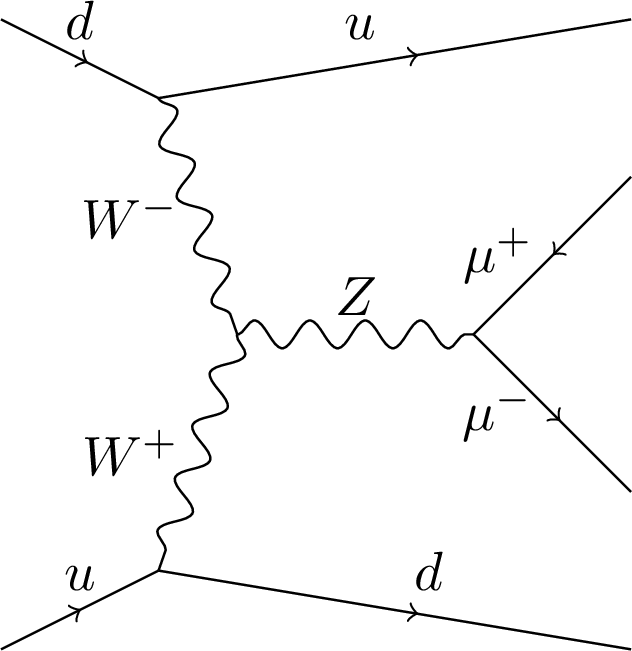
png pdf |
Figure 1-a:
Representative Feynman diagram for purely electroweak dilepton production in association with two jets: vector boson fusion. |

png pdf |
Figure 1-b:
Representative Feynman diagram for purely electroweak dilepton production in association with two jets: bremsstrahlung-like production. |

png pdf |
Figure 1-c:
Representative Feynman diagram for purely electroweak dilepton production in association with two jets: multiperipheral production. |

png pdf |
Figure 2:
Representative Feynman diagrams for order $\alpha _\mathrm {S}^2$ corrections to DY production that constitute the main background for the measurement. |
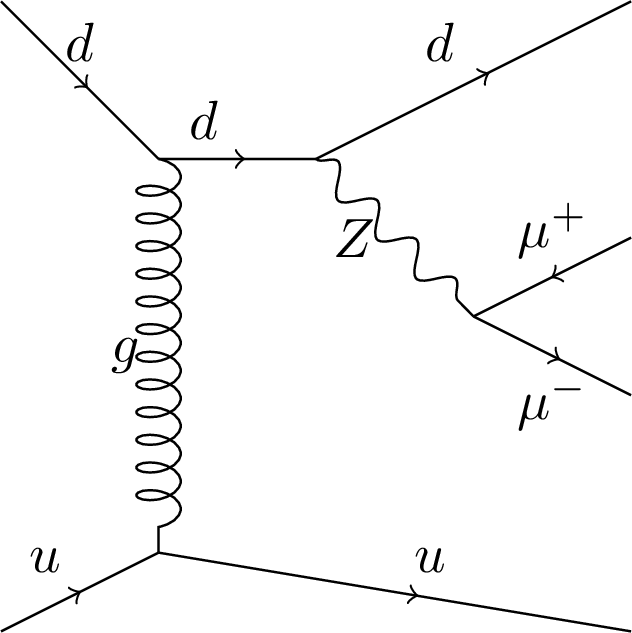
png pdf |
Figure 2-a:
Representative Feynman diagram for order $\alpha _\mathrm {S}^2$ correction to DY production that constitute the main background for the measurement. |
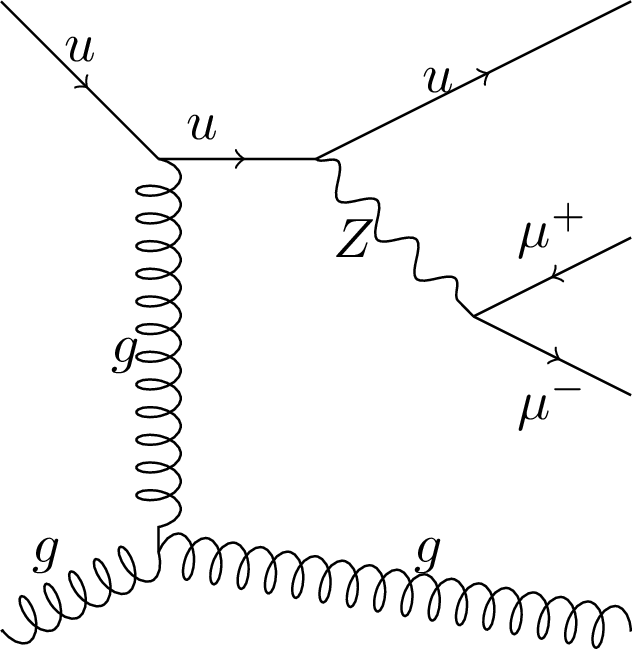
png pdf |
Figure 2-b:
Representative Feynman diagram for order $\alpha _\mathrm {S}^2$ correction to DY production that constitute the main background for the measurement. |
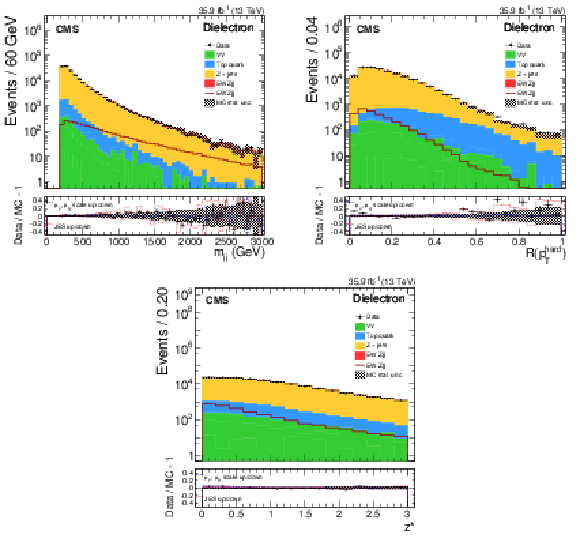
png pdf |
Figure 3:
Data and simulated event distributions for the dielectron event selection: $m_{\mathrm {jj}}$ (top left), $R({p_{\mathrm {T}}} ^{\,\text {hard}})$ (top right), and $z^*$ (bottom). The contributions from the different background sources and the signal are shown stacked, with data points superimposed. The expected signal-only contribution is also shown as an unfilled histogram. The lower panels show the relative difference between the data and expectations, as well as the uncertainty envelopes for JES and $\mu _{\rm F,R}$ scale uncertainties. |
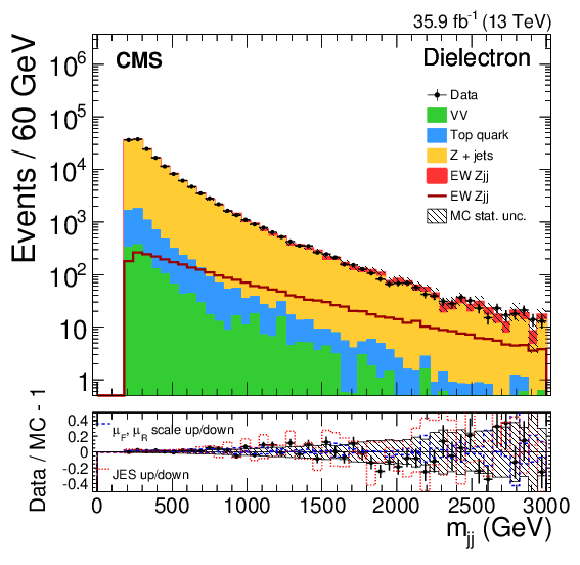
png pdf |
Figure 3-a:
Data and simulated event $m_{\mathrm {jj}}$ distributions for the dielectron event selection. The contributions from the different background sources and the signal are shown stacked, with data points superimposed. The expected signal-only contribution is also shown as an unfilled histogram. The lower panel shows the relative difference between the data and expectations, as well as the uncertainty envelopes for JES and $\mu _{\rm F,R}$ scale uncertainties. |
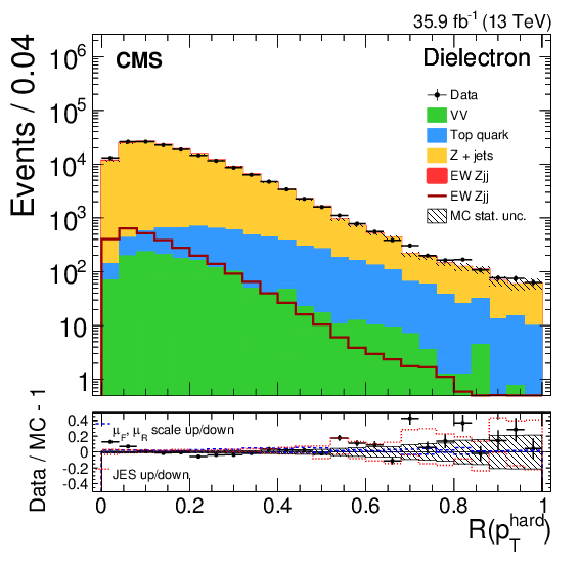
png pdf |
Figure 3-b:
Data and simulated event $R({p_{\mathrm {T}}} ^{\,\text {hard}})$ distributions for the dielectron event selection. The contributions from the different background sources and the signal are shown stacked, with data points superimposed. The expected signal-only contribution is also shown as an unfilled histogram. The lower panel shows the relative difference between the data and expectations, as well as the uncertainty envelopes for JES and $\mu _{\rm F,R}$ scale uncertainties. |
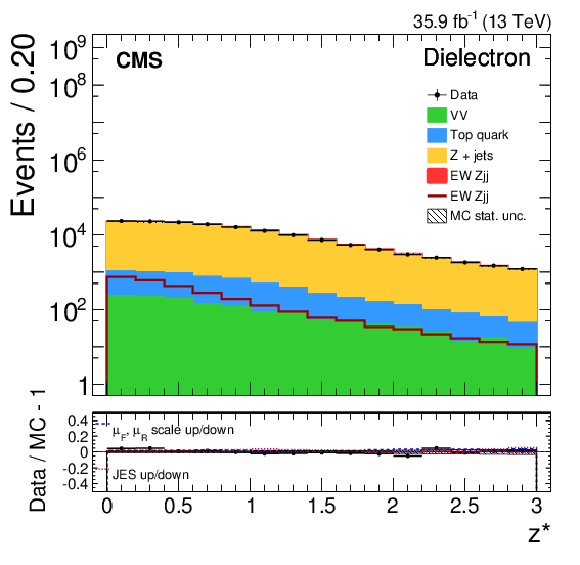
png pdf |
Figure 3-c:
Data and simulated event $z^*$ distribution for the dielectrons event selection. The contributions from the different background sources and the signal are shown stacked, with data points superimposed. The expected signal-only contribution is also shown as an unfilled histogram. The lower panel shows the relative difference between the data and expectations, as well as the uncertainty envelopes for JES and $\mu _{\rm F,R}$ scale uncertainties. |
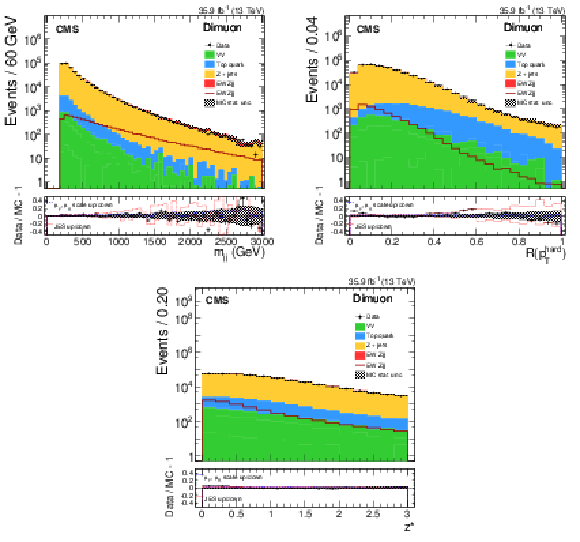
png pdf |
Figure 4:
Data and simulated event distributions for the dimuon event selection: $m_{\mathrm {jj}}$ (top left), $R({p_{\mathrm {T}}} ^{\,\text {hard}})$ (top right), and $z^*$ (bottom). The contributions from the different background sources and the signal are shown stacked, with data points superimposed. The expected signal-only contribution is also shown as an unfilled histogram. The lower panels show the relative difference between the data and expectations as well as the uncertainty envelopes for JES and $\mu _{\rm F,R}$ scale uncertainties. |
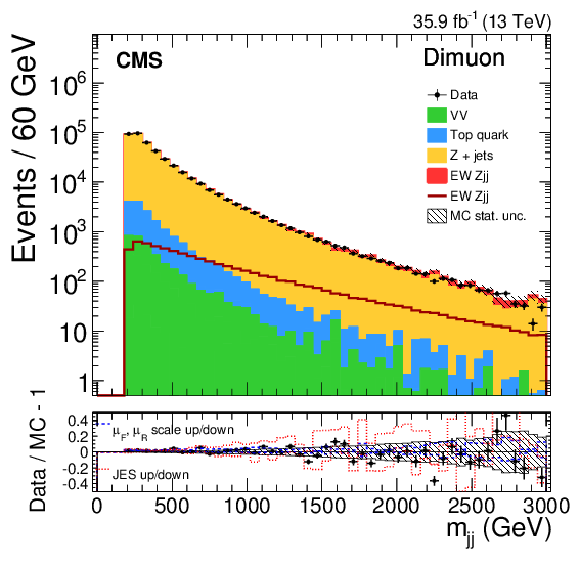
png pdf |
Figure 4-a:
Data and simulated event $m_{\mathrm {jj}}$ distributions for the dimuon event selection. The contributions from the different background sources and the signal are shown stacked, with data points superimposed. The expected signal-only contribution is also shown as an unfilled histogram. The lower panel shows the relative difference between the data and expectations as well as the uncertainty envelopes for JES and $\mu _{\rm F,R}$ scale uncertainties. |
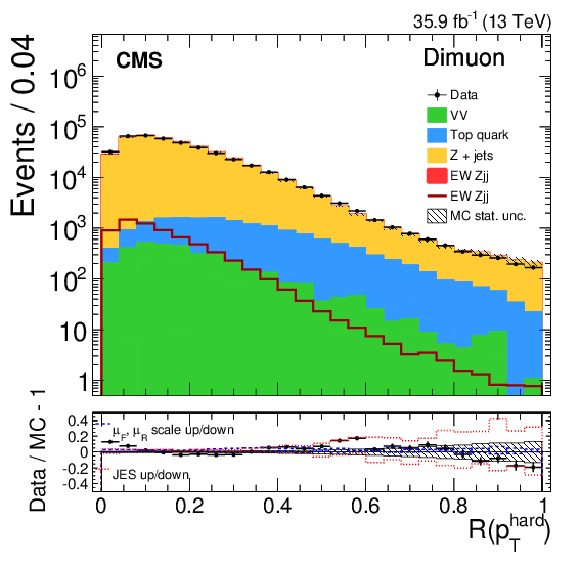
png pdf |
Figure 4-b:
Data and simulated event $R({p_{\mathrm {T}}} ^{\,\text {hard}})$ distributions for the dimuon event selection. The contributions from the different background sources and the signal are shown stacked, with data points superimposed. The expected signal-only contribution is also shown as an unfilled histogram. The lower panel shows the relative difference between the data and expectations as well as the uncertainty envelopes for JES and $\mu _{\rm F,R}$ scale uncertainties. |
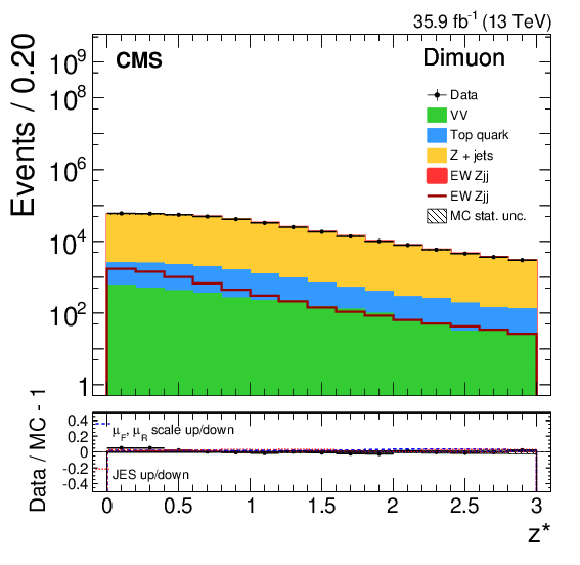
png pdf |
Figure 4-c:
Data and simulated event $z^*$ distributions for the dimuon event selection. The contributions from the different background sources and the signal are shown stacked, with data points superimposed. The expected signal-only contribution is also shown as an unfilled histogram. The lower panel shows the relative difference between the data and expectations as well as the uncertainty envelopes for JES and $\mu _{\rm F,R}$ scale uncertainties. |
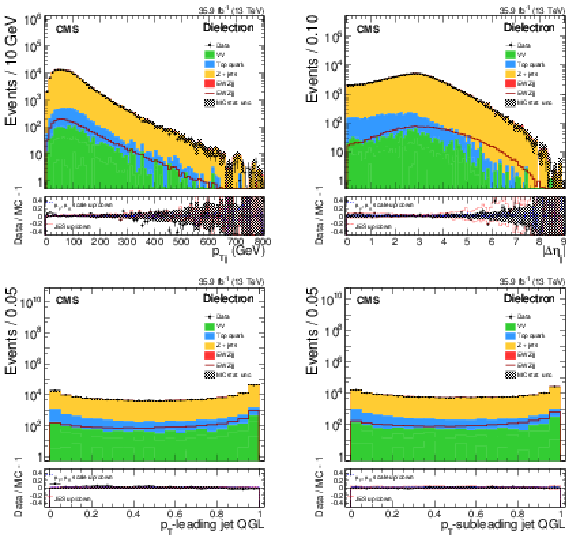
png pdf |
Figure 5:
Data and simulated event distributions for the dielectron event selection: dijet system transverse momentum (top left), dijet pseudorapidity opening (top right), ${p_{\mathrm {T}}} $-leading jet QGL (bottom left), and ${p_{\mathrm {T}}} $-subleading jet QGL (bottom right). The contributions from the different background sources and the signal are shown stacked, with data points superimposed. The expected signal-only contribution is also shown as an unfilled histogram. The lower panels show the relative difference between the data and expectations, as well as the uncertainty envelopes for JES and $\mu _{\rm F,R}$ scale uncertainties. |

png pdf |
Figure 5-a:
Data and simulated event dijet system transverse momentum distributions for the dielectron event selection. The contributions from the different background sources and the signal are shown stacked, with data points superimposed. The expected signal-only contribution is also shown as an unfilled histogram. The lower panel shows the relative difference between the data and expectations, as well as the uncertainty envelopes for JES and $\mu _{\rm F,R}$ scale uncertainties. |

png pdf |
Figure 5-b:
Data and simulated event dijet pseudorapidity opening distributions for the dielectron event selection. The contributions from the different background sources and the signal are shown stacked, with data points superimposed. The expected signal-only contribution is also shown as an unfilled histogram. The lower panel shows the relative difference between the data and expectations, as well as the uncertainty envelopes for JES and $\mu _{\rm F,R}$ scale uncertainties. |
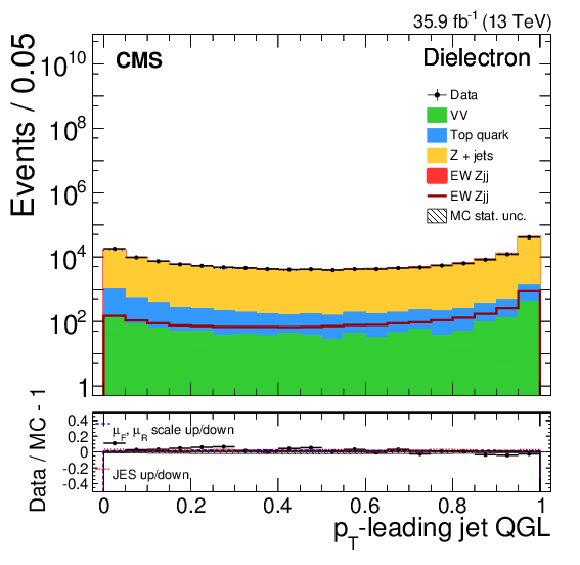
png pdf |
Figure 5-c:
Data and simulated event ${p_{\mathrm {T}}} $-leading jet QGL distributions for the dielectron event selection. The contributions from the different background sources and the signal are shown stacked, with data points superimposed. The expected signal-only contribution is also shown as an unfilled histogram. The lower panel shows the relative difference between the data and expectations, as well as the uncertainty envelopes for JES and $\mu _{\rm F,R}$ scale uncertainties. |
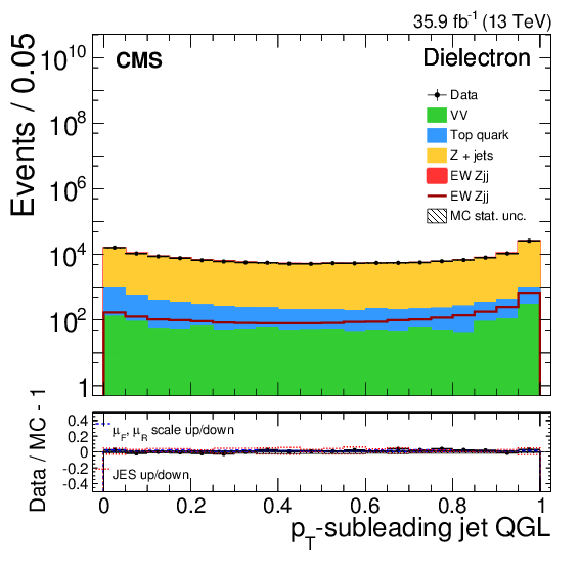
png pdf |
Figure 5-d:
Data and simulated event ${p_{\mathrm {T}}} $-subleading jet QGL distributions for the dielectron event selection. The contributions from the different background sources and the signal are shown stacked, with data points superimposed. The expected signal-only contribution is also shown as an unfilled histogram. The lower panel shows the relative difference between the data and expectations, as well as the uncertainty envelopes for JES and $\mu _{\rm F,R}$ scale uncertainties. |

png pdf |
Figure 6:
Data and simulated event distributions for the dimuon event selection: dijet system transverse momentum (top left), dijet pseudorapidity opening (top right), ${p_{\mathrm {T}}} $-leading jet QGL (bottom left), and ${p_{\mathrm {T}}} $-subleading jet QGL (bottom right). The contributions from the different background sources and the signal are shown stacked, with data points superimposed. The expected signal-only contribution is also shown as an unfilled histogram. The lower panels show the relative difference between the data and expectations, as well as the uncertainty envelopes for JES and $\mu _{\rm F,R}$ scale uncertainties. |
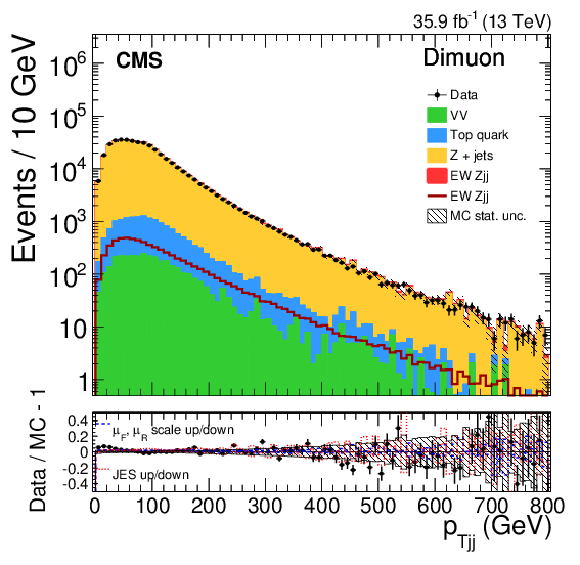
png pdf |
Figure 6-a:
Data and simulated event dijet system transverse momentum distributions for the dimuon event selection. The contributions from the different background sources and the signal are shown stacked, with data points superimposed. The expected signal-only contribution is also shown as an unfilled histogram. The lower panel shows the relative difference between the data and expectations, as well as the uncertainty envelopes for JES and $\mu _{\rm F,R}$ scale uncertainties. |

png pdf |
Figure 6-b:
Data and simulated event dijet system transverse momentum distributions for the dimuon event selection. The contributions from the different background sources and the signal are shown stacked, with data points superimposed. The expected signal-only contribution is also shown as an unfilled histogram. The lower panel shows the relative difference between the data and expectations, as well as the uncertainty envelopes for JES and $\mu _{\rm F,R}$ scale uncertainties. |
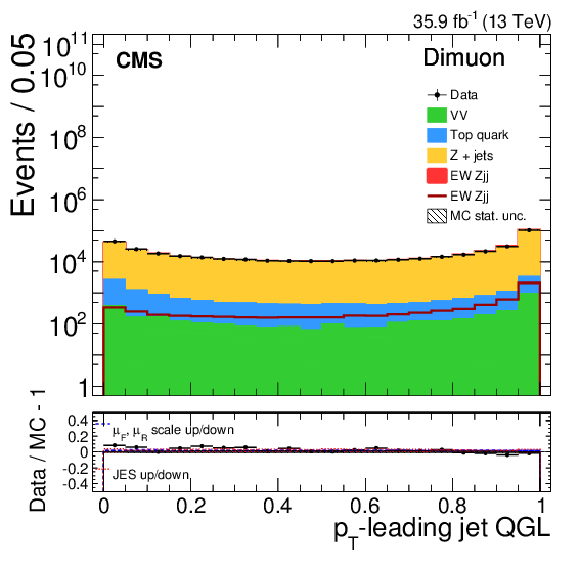
png pdf |
Figure 6-c:
Data and simulated event ${p_{\mathrm {T}}} $-leading jet QGL distributions for the dimuon event selection. The contributions from the different background sources and the signal are shown stacked, with data points superimposed. The expected signal-only contribution is also shown as an unfilled histogram. The lower panel shows the relative difference between the data and expectations, as well as the uncertainty envelopes for JES and $\mu _{\rm F,R}$ scale uncertainties. |
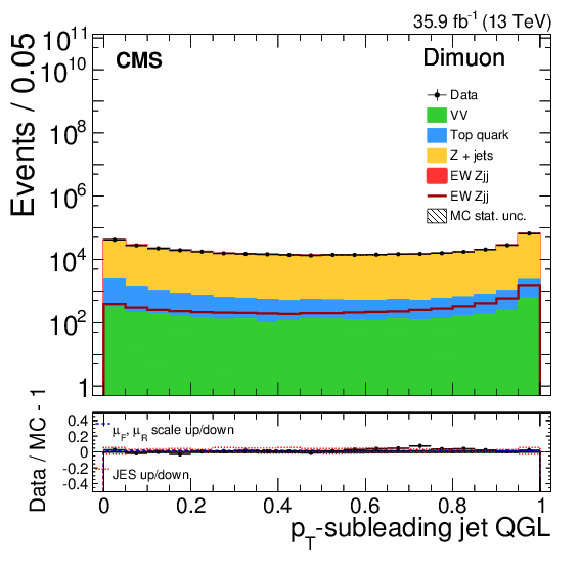
png pdf |
Figure 6-d:
Data and simulated event ${p_{\mathrm {T}}} $-subleading jet QGL distributions for the dimuon event selection. The contributions from the different background sources and the signal are shown stacked, with data points superimposed. The expected signal-only contribution is also shown as an unfilled histogram. The lower panel shows the relative difference between the data and expectations, as well as the uncertainty envelopes for JES and $\mu _{\rm F,R}$ scale uncertainties. |

png pdf |
Figure 7:
Distributions for transformed BDT discriminants in dielectron (left) and dimuon (right) events. The contributions from the different background sources and the signal are shown stacked, with data points superimposed. The expected signal-only contribution is also shown as an unfilled histogram. The lower panels show the relative difference between the data and expectations, as well as the uncertainty envelopes for JES and $\mu _{\rm F,R}$ scale uncertainties. |
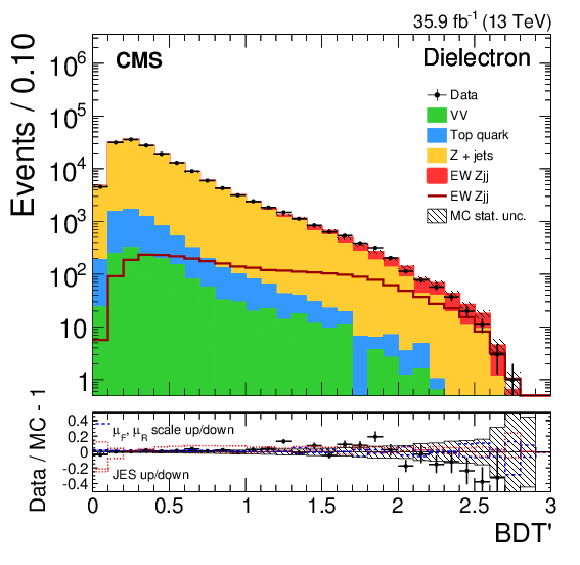
png pdf |
Figure 7-a:
Distributions for transformed BDT discriminants in dielectron events. The contributions from the different background sources and the signal are shown stacked, with data points superimposed. The expected signal-only contribution is also shown as an unfilled histogram. The lower panel shows the relative difference between the data and expectations, as well as the uncertainty envelopes for JES and $\mu _{\rm F,R}$ scale uncertainties. |
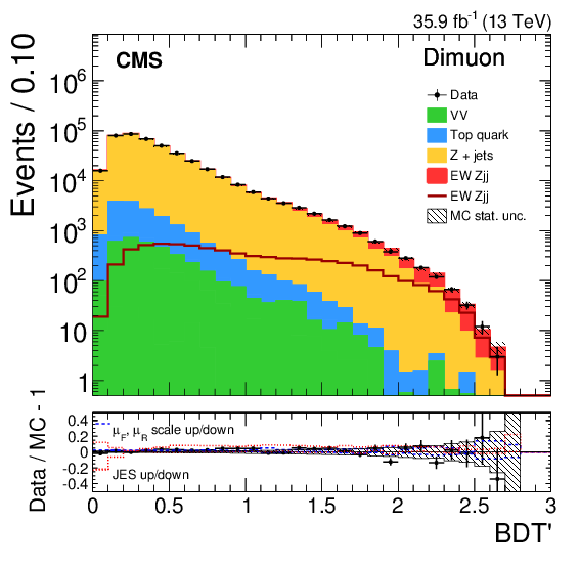
png pdf |
Figure 7-b:
Distributions for transformed BDT discriminants in dimuon events. The contributions from the different background sources and the signal are shown stacked, with data points superimposed. The expected signal-only contribution is also shown as an unfilled histogram. The lower panel shows the relative difference between the data and expectations, as well as the uncertainty envelopes for JES and $\mu _{\rm F,R}$ scale uncertainties. |
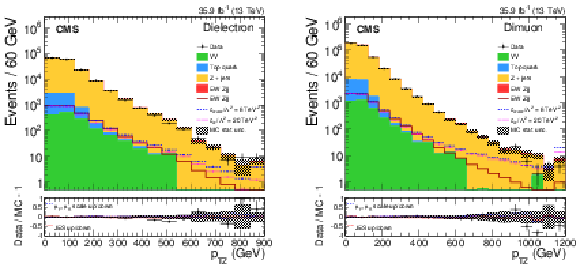
png pdf |
Figure 8:
Distributions of $p_{\mathrm {T} {\mathrm {Z}}}$ in data and SM backgrounds, and various ATGC scenarios in the dielectron (left) and dimuon (right) channels. |
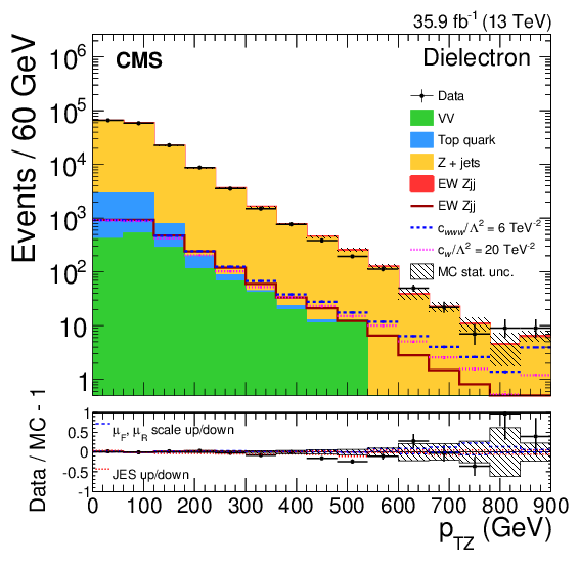
png pdf |
Figure 8-a:
Distributions of $p_{\mathrm {T} {\mathrm {Z}}}$ in data and SM backgrounds, and various ATGC scenarios in the dielectron channel. |
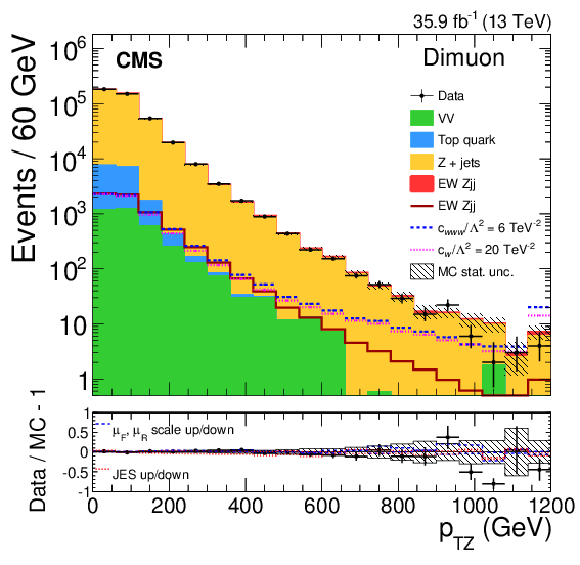
png pdf |
Figure 8-b:
Distributions of $p_{\mathrm {T} {\mathrm {Z}}}$ in data and SM backgrounds, and various ATGC scenarios in the dimuon channel. |

png pdf |
Figure 9:
Two-dimensional observed 95% CL limits (continuous black line) and expected 68%, 95%, and 99% CL limits on anomalous coupling parameters. |

png pdf |
Figure 9-a:
Two-dimensional observed 95% CL limits (continuous black line) and expected 68%, 95%, and 99% CL limits on anomalous coupling parameters. |

png pdf |
Figure 9-b:
Two-dimensional observed 95% CL limits (continuous black line) and expected 68%, 95%, and 99% CL limits on anomalous coupling parameters. |
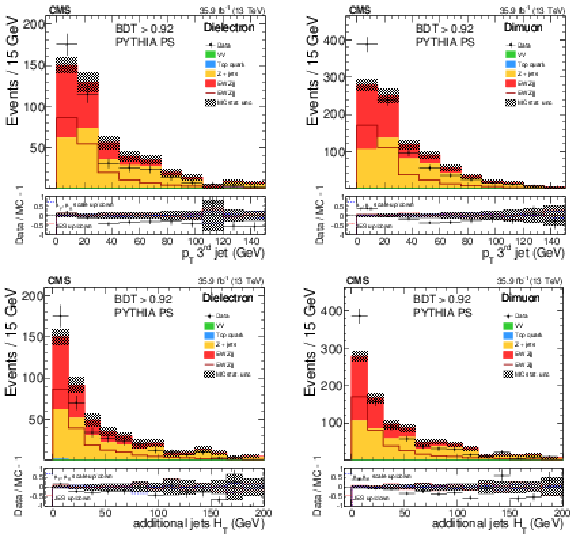
png pdf |
Figure 10:
Transverse momentum of the third highest ${p_{\mathrm {T}}}$ jet (top row), and $ {H_{\mathrm {T}}} $ of all additional jets (bottom row) within the pseudorapidity interval of the two tagging jets in dielectron (left) and dimuon (right) events with BDT $>$ 0.92. The contributions from the different background sources and the signal are shown stacked, with data points superimposed. The expected signal-only contribution is also shown as an unfilled histogram. The lower panels show the relative difference between the data and expectations, as well as the uncertainty envelopes for JES and $\mu _{\rm F,R}$ scale uncertainties. In all distributions the first bin contains events where no additional jet with $ {p_{\mathrm {T}}} > $ 15 GeV is present. |
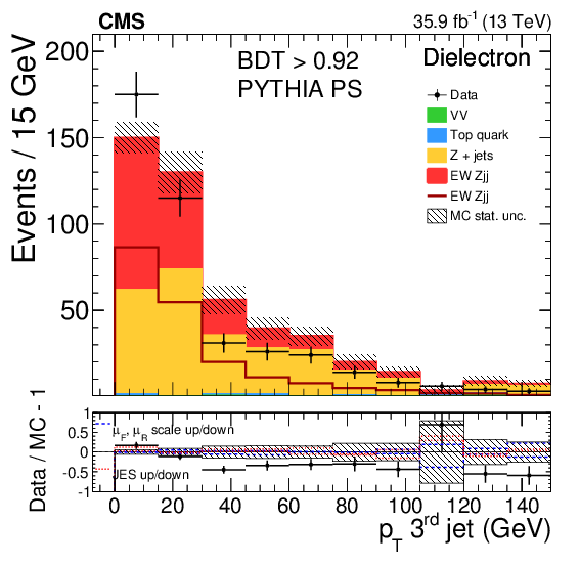
png pdf |
Figure 10-a:
Transverse momentum of the third highest ${p_{\mathrm {T}}}$ jet within the pseudorapidity interval of the two tagging jets in dielectron events with BDT $>$ 0.92. The contributions from the different background sources and the signal are shown stacked, with data points superimposed. The expected signal-only contribution is also shown as an unfilled histogram. The lower panel shows the relative difference between the data and expectations, as well as the uncertainty envelopes for JES and $\mu _{\rm F,R}$ scale uncertainties. In all distributions the first bin contains events where no additional jet with $ {p_{\mathrm {T}}} > $ 15 GeV is present. |
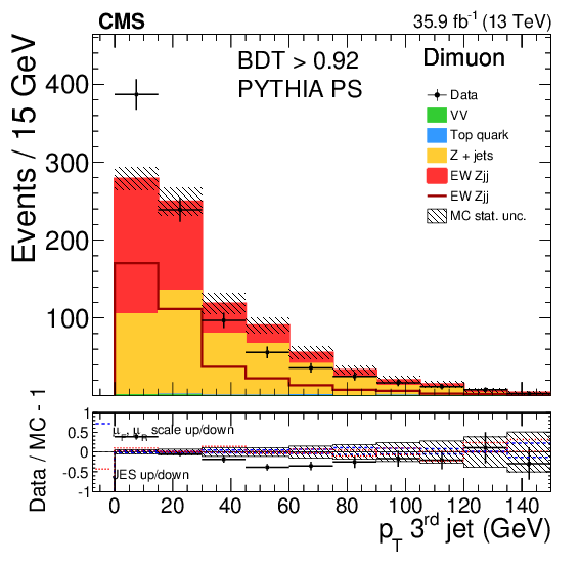
png pdf |
Figure 10-b:
Transverse momentum of the third highest ${p_{\mathrm {T}}}$ jet within the pseudorapidity interval of the two tagging jets in dimuon events with BDT $>$ 0.92. The contributions from the different background sources and the signal are shown stacked, with data points superimposed. The expected signal-only contribution is also shown as an unfilled histogram. The lower panel shows the relative difference between the data and expectations, as well as the uncertainty envelopes for JES and $\mu _{\rm F,R}$ scale uncertainties. In all distributions the first bin contains events where no additional jet with $ {p_{\mathrm {T}}} > $ 15 GeV is present. |

png pdf |
Figure 10-c:
$ {H_{\mathrm {T}}} $ of all additional jets within the pseudorapidity interval of the two tagging jets in dielectron events with BDT $>$ 0.92. The contributions from the different background sources and the signal are shown stacked, with data points superimposed. The expected signal-only contribution is also shown as an unfilled histogram. The lower panel shows the relative difference between the data and expectations, as well as the uncertainty envelopes for JES and $\mu _{\rm F,R}$ scale uncertainties. In all distributions the first bin contains events where no additional jet with $ {p_{\mathrm {T}}} > $ 15 GeV is present. |
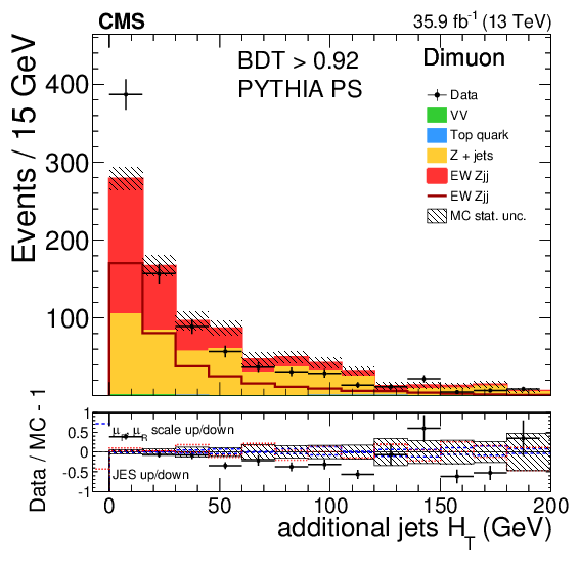
png pdf |
Figure 10-d:
$ {H_{\mathrm {T}}} $ of all additional jets within the pseudorapidity interval of the two tagging jets in dimuon events with BDT $>$ 0.92. The contributions from the different background sources and the signal are shown stacked, with data points superimposed. The expected signal-only contribution is also shown as an unfilled histogram. The lower panel shows the relative difference between the data and expectations, as well as the uncertainty envelopes for JES and $\mu _{\rm F,R}$ scale uncertainties. In all distributions the first bin contains events where no additional jet with $ {p_{\mathrm {T}}} > $ 15 GeV is present. |

png pdf |
Figure 11:
$ {H_{\mathrm {T}}} $ of additional soft track-jets with $ {p_{\mathrm {T}}} > $ 1 GeV in dielectron (left) and dimuon (right) events with BDT $>$ 0.92. Data are compared to MC expectations with the PYTHIA PS model (top row), or the HERWIG++ PS model (bottom row). The contributions from the different background sources and the signal are shown stacked, with data points superimposed. The expected signal-only contribution is also shown as an unfilled histogram. The lower panels show the relative difference between the data and expectations, as well as the uncertainty envelopes for JES and $\mu _{\rm F,R}$ scale uncertainties. |

png pdf |
Figure 11-a:
$ {H_{\mathrm {T}}} $ of additional soft track-jets with $ {p_{\mathrm {T}}} > $ 1 GeV in dielectron events with BDT $>$ 0.92. Data are compared to MC expectations with the PYTHIA PS model. The contributions from the different background sources and the signal are shown stacked, with data points superimposed. The expected signal-only contribution is also shown as an unfilled histogram. The lower panel shows the relative difference between the data and expectations, as well as the uncertainty envelopes for JES and $\mu _{\rm F,R}$ scale uncertainties. |
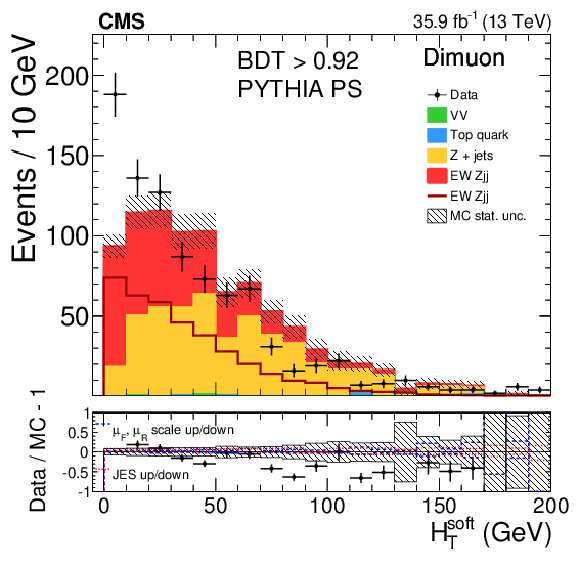
png pdf |
Figure 11-b:
$ {H_{\mathrm {T}}} $ of additional soft track-jets with $ {p_{\mathrm {T}}} > $ 1 GeV in dimuon events with BDT $>$ 0.92. Data are compared to MC expectations with the PYTHIA PS model. The contributions from the different background sources and the signal are shown stacked, with data points superimposed. The expected signal-only contribution is also shown as an unfilled histogram. The lower panel shows the relative difference between the data and expectations, as well as the uncertainty envelopes for JES and $\mu _{\rm F,R}$ scale uncertainties. |

png pdf |
Figure 11-c:
$ {H_{\mathrm {T}}} $ of additional soft track-jets with $ {p_{\mathrm {T}}} > $ 1 GeV in dielectron events with BDT $>$ 0.92. Data are compared to MC expectations with the HERWIG++ PS model. The contributions from the different background sources and the signal are shown stacked, with data points superimposed. The expected signal-only contribution is also shown as an unfilled histogram. The lower panel shows the relative difference between the data and expectations, as well as the uncertainty envelopes for JES and $\mu _{\rm F,R}$ scale uncertainties. |
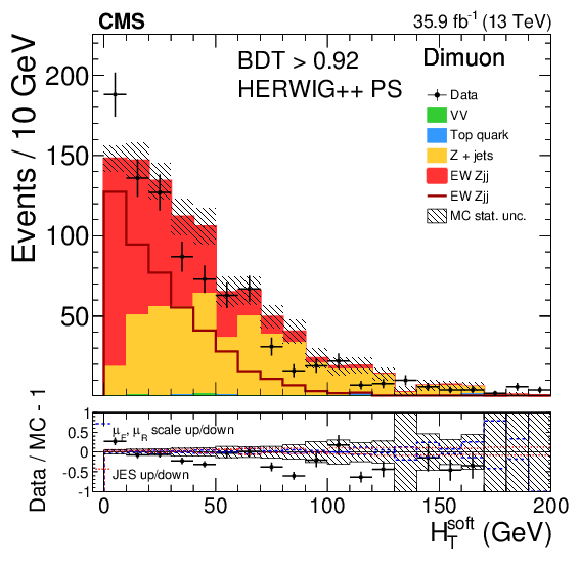
png pdf |
Figure 11-d:
$ {H_{\mathrm {T}}} $ of additional soft track-jets with $ {p_{\mathrm {T}}} > $ 1 GeV in dimuon events with BDT $>$ 0.92. Data are compared to MC expectations with the HERWIG++ PS model. The contributions from the different background sources and the signal are shown stacked, with data points superimposed. The expected signal-only contribution is also shown as an unfilled histogram. The lower panel shows the relative difference between the data and expectations, as well as the uncertainty envelopes for JES and $\mu _{\rm F,R}$ scale uncertainties. |

png pdf |
Figure 12:
Efficiency of a gap activity veto in dielectron and dimuon events with BDT $>$ 0.92, as a function of the additional jet ${p_{\mathrm {T}}}$ (left), and of the total ${H_{\mathrm {T}}}$ of additional jets (right). Data points are compared to MC expectations with only DY events, including signal with the PYTHIA PS model, or the HERWIG++ PS model. The bands represent the MC statistical uncertainty. |
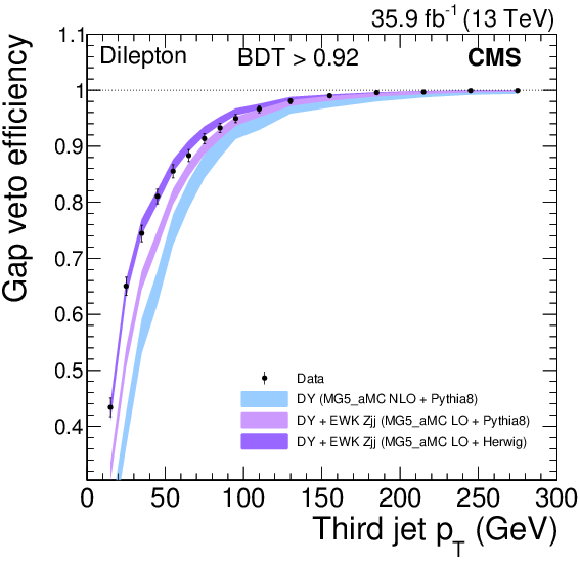
png pdf |
Figure 12-a:
Efficiency of a gap activity veto in dielectron and dimuon events with BDT $>$ 0.92, as a function of the additional jet ${p_{\mathrm {T}}}$. Data points are compared to MC expectations with only DY events, including signal with the PYTHIA PS model, or the HERWIG++ PS model. The bands represent the MC statistical uncertainty. |
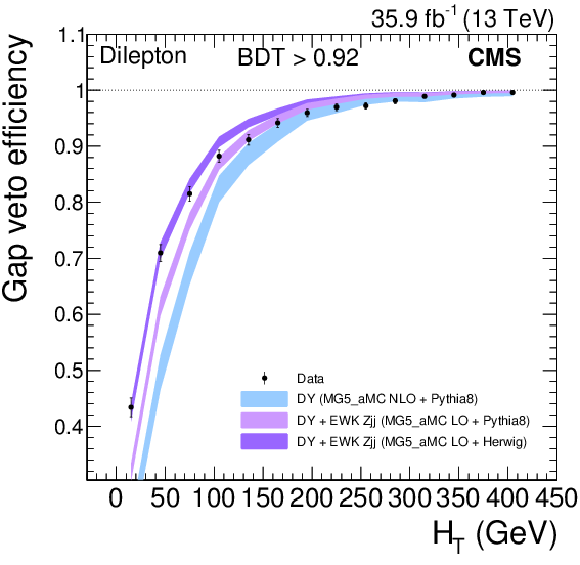
png pdf |
Figure 12-b:
Efficiency of a gap activity veto in dielectron and dimuon events with BDT $>$ 0.92, as a function of the total ${H_{\mathrm {T}}}$ of additional jets. Data points are compared to MC expectations with only DY events, including signal with the PYTHIA PS model, or the HERWIG++ PS model. The bands represent the MC statistical uncertainty. |
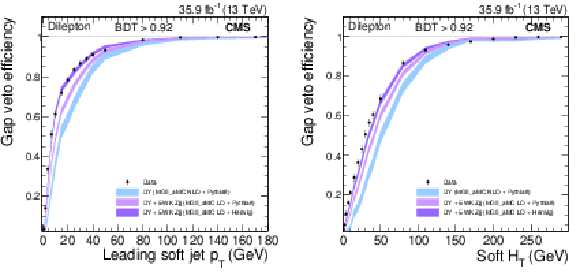
png pdf |
Figure 13:
Efficiency of a gap activity veto in dielectron and dimuon events with BDT $>$ 0.92, as a function of the leading soft track-jet ${p_{\mathrm {T}}}$ (left), and of the total soft ${H_{\mathrm {T}}}$ (right). Data points are compared to MC expectations with only DY events, including signal with the PYTHIA PS model, or the HERWIG++ PS model. The bands represent the MC statistical uncertainty. |
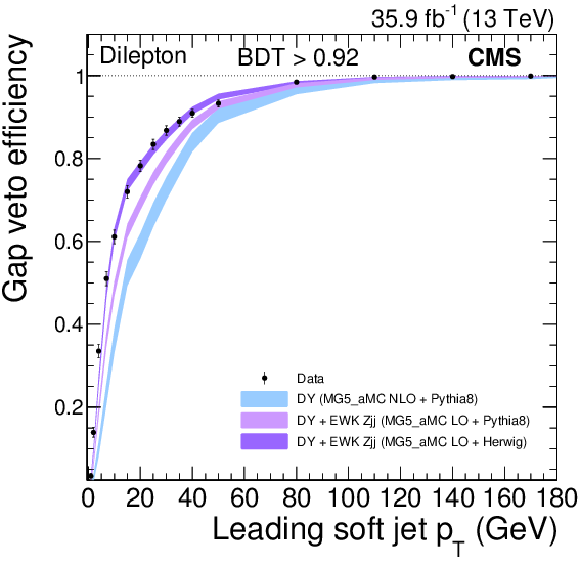
png pdf |
Figure 13-a:
Efficiency of a gap activity veto in dielectron and dimuon events with BDT $>$ 0.92, as a function of the leading soft track-jet ${p_{\mathrm {T}}}$. Data points are compared to MC expectations with only DY events, including signal with the PYTHIA PS model, or the HERWIG++ PS model. The bands represent the MC statistical uncertainty. |

png pdf |
Figure 13-b:
Efficiency of a gap activity veto in dielectron and dimuon events with BDT $>$ 0.92, as a function of the total soft ${H_{\mathrm {T}}}$. Data points are compared to MC expectations with only DY events, including signal with the PYTHIA PS model, or the HERWIG++ PS model. The bands represent the MC statistical uncertainty. |
| Tables | |
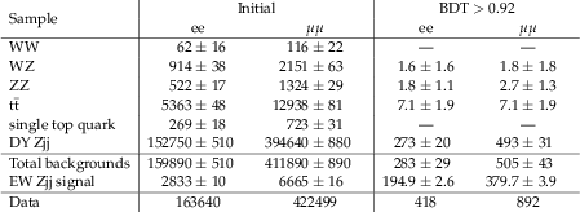
png pdf |
Table 1:
Event yields expected for background and signal processes using the initial selections and with a cut on the multivariate analysis output (BDT) that provides signal $\approx $ background. The yields are compared to the data observed in the different channels and categories. The total uncertainties quoted for signal, DY Zjj, dibosons, and processes with top quarks (${\mathrm {t}\overline {\mathrm {t}}}$ and single top quarks) include relevant systematic uncertainties. |

png pdf |
Table 2:
One-dimensional limits on the ATGC EFT parameters at 95% CL. |

png pdf |
Table 3:
One-dimensional limits on the ATGC effective Lagrangian (LEP parametrization) parameters at 95% CL. |
| Summary |
|
The cross section for the electroweak (EW) production of a Z boson in association with two jets in the ${\ell\ell\mathrm{jj}} $ final state is measured in proton-proton collisions at $\sqrt{s} = $ 13 TeV in the kinematic region defined by $m_{\ell\ell} > $ 50 GeV, $m_{\mathrm{jj}} > $ 120 GeV, and transverse momenta $p_\mathrm{T j} > $ 25 GeV. The result agrees with the standard model prediction. This is the first observation of the EW Zjj production in proton-proton collisions at $\sqrt{s}= $ 13 TeV. The increased cross section and integrated luminosity recorded at 13 TeV, as well as the more precise NLO modelling of background processes, have led to a more precise measurement of the EW Zjj process, relative to earlier results, where the relative precision was approximately 20% [11]. No evidence for anomalous trilinear gauge couplings is found. The following one-dimensional limits at 95% CL are obtained: $-2.6 < c_{WWW}/\Lambda^2 < 2.6 $ TeV$^{-2}$ and $-8.4 < c_{W}/\Lambda^2 < 10.1 $ TeV$^{-2}$. These results provide the most stringent constraints on $c_{WWW}$ to date. In events from a signal-enriched region, the additional hadron activity is also studied, as well as the efficiencies for a gap-activity veto, and generally good agreement is found between data and quantum chromodynamics predictions with either the PYTHIA or HERWIG++ parton shower and hadronization model. |
| References | ||||
| 1 | C. Oleari and D. Zeppenfeld | QCD corrections to electroweak $ \ell\nu_\ell\mathrm{jj} $ and $ \ell^+\ell^-\mathrm{jj} $ production | PRD 69 (2004) 093004 | hep-ph/0310156 |
| 2 | ATLAS Collaboration | Observation of a new particle in the search for the Standard Model Higgs boson with the ATLAS detector at the LHC | PLB 716 (2012) 1 | 1207.7214 |
| 3 | CMS Collaboration | Observation of a new boson at a mass of 125 GeV with the CMS experiment at the LHC | PLB 716 (2012) 30 | CMS-HIG-12-028 1207.7235 |
| 4 | CMS Collaboration | Observation of a new boson with mass near 125 GeV in pp collisions at $ \sqrt{s} = $ 7 and 8 TeV | JHEP 06 (2013) 081 | CMS-HIG-12-036 1303.4571 |
| 5 | G.-C. Cho et al. | Weak boson fusion production of supersymmetric particles at the CERN LHC | PRD 73 (2006) 054002 | hep-ph/0601063 |
| 6 | J. D. Bjorken | Rapidity gaps and jets as a new physics signature in very high-energy hadron hadron collisions | PRD 47 (1993) 101 | |
| 7 | F. Schissler and D. Zeppenfeld | Parton shower effects on W and Z production via vector boson fusion at NLO QCD | JHEP 04 (2013) 057 | 1302.2884 |
| 8 | K. Hagiwara, S. Ishihara, R. Szalapski, and D. Zeppenfeld | Low-energy effects of new interactions in the electroweak boson sector | PRD 48 (1993) 2182 | |
| 9 | C. Degrande et al. | Effective field theory: a modern approach to anomalous couplings | Annals Phys. 335 (2013) 21 | 1205.4231 |
| 10 | CMS Collaboration | Measurement of the hadronic activity in events with a Z and two jets and extraction of the cross section for the electroweak production of a Z with two jets in pp collisions at $ \sqrt{s} = $ 7 TeV | JHEP 10 (2013) 062 | CMS-FSQ-12-019 1305.7389 |
| 11 | CMS Collaboration | Measurement of electroweak production of two jets in association with a Z boson in proton-proton collisions at $ \sqrt{s} = $ 8 TeV | EPJC 75 (2015) 66 | CMS-FSQ-12-035 1410.3153 |
| 12 | ATLAS Collaboration | Measurement of the electroweak production of dijets in association with a Z-boson and distributions sensitive to vector boson fusion in proton-proton collisions at $ \sqrt{s} = $ 8 TeV using the ATLAS detector | JHEP 04 (2014) 031 | 1401.7610 |
| 13 | ATLAS Collaboration | Measurement of the cross-section for electroweak production of dijets in association with a Z boson in pp collisions at $ \sqrt{s} = $ 13 TeV with the ATLAS detector | Phys. Lett.B 775 (2017) 206 | 1709.10264 |
| 14 | CMS Collaboration | Description and performance of track and primary-vertex reconstruction with the CMS tracker | JINST 9 (2014) P10009 | CMS-TRK-11-001 1405.6569 |
| 15 | CMS Collaboration | Performance of electron reconstruction and selection with the CMS detector in proton-proton collisions at $ \sqrt{s} = $ 8 TeV | JINST 10 (2015) P06005 | CMS-EGM-13-001 1502.02701 |
| 16 | CMS Collaboration | Performance of CMS muon reconstruction in pp collision events at $ \sqrt{s} = $ 7 TeV | JINST 7 (2012) P10002 | CMS-MUO-10-004 1206.4071 |
| 17 | CMS Collaboration | Particle-flow reconstruction and global event description with the CMS detector | JINST 12 (2017) P10003 | CMS-PRF-14-001 1706.04965 |
| 18 | CMS Collaboration | The CMS experiment at the CERN LHC | JINST 3 (2008) S08004 | CMS-00-001 |
| 19 | J. Alwall et al. | MadGraph 5: going beyond | JHEP 06 (2011) 128 | 1106.0522 |
| 20 | J. Alwall et al. | The automated computation of tree-level and next-to-leading order differential cross sections, and their matching to parton shower simulations | JHEP 07 (2014) 079 | 1405.0301 |
| 21 | T. Sjostrand, S. Mrenna, and P. Skands | A brief introduction to PYTHIA 8.1 | CPC 178 (2008) 852 | 0710.3820 |
| 22 | T. Sjostrand et al. | An introduction to PYTHIA 8.2 | CPC 191 (2015) 159 | 1410.3012 |
| 23 | NNPDF Collaboration | Unbiased global determination of parton distributions and their uncertainties at NNLO and at LO | NPB 855 (2012) 153 | 1107.2652 |
| 24 | CMS Collaboration | Event generator tunes obtained from underlying event and multiparton scattering measurements | EPJC 76 (2016) 155 | CMS-GEN-14-001 1512.00815 |
| 25 | K. Arnold et al. | VBFNLO: a parton level Monte Carlo for processes with electroweak bosons | CPC 180 (2009) 1661 | 0811.4559 |
| 26 | J. Baglio et al. | VBFNLO: a parton level Monte Carlo for processes with electroweak bosons --- manual for version 2.7.0 | 1107.4038 | |
| 27 | K. Arnold et al. | Release note --- VBFNLO-2.6.0 | 1207.4975 | |
| 28 | M. Bahr et al. | Herwig++ physics and manual | EPJC 58 (2008) 639 | 0803.0883 |
| 29 | M. H. Seymour and A. Siodmok | Constraining MPI models using $ \sigma_{\text{eff}} $ and recent Tevatron and LHC underlying event data | JHEP 10 (2013) 113 | 1307.5015 |
| 30 | R. Frederix and S. Frixione | Merging meets matching in MC@NLO | JHEP 12 (2012) 061 | 1209.6215 |
| 31 | M. L. Mangano, M. Moretti, F. Piccinini, and M. Treccani | Matching matrix elements and shower evolution for top-quark production in hadronic collisions | JHEP 01 (2007) 013 | hep-ph/0611129 |
| 32 | J. Alwall et al. | Comparative study of various algorithms for the merging of parton showers and matrix elements in hadronic collisions | EPJC 53 (2008) 473 | 0706.2569 |
| 33 | K. Melnikov and F. Petriello | Electroweak gauge boson production at hadron colliders through $ \mathcal{O}(\alpha_S^2) $ | PRD 74 (2006) 114017 | hep-ph/0609070 |
| 34 | P. Nason | A new method for combining NLO QCD with shower Monte Carlo algorithms | JHEP 11 (2004) 040 | hep-ph/0409146 |
| 35 | S. Frixione, P. Nason, and C. Oleari | Matching NLO QCD computations with parton shower simulations: the POWHEG method | JHEP 11 (2007) 070 | 0709.2092 |
| 36 | S. Alioli, P. Nason, C. Oleari, and E. Re | A general framework for implementing NLO calculations in shower Monte Carlo programs: the POWHEG BOX | JHEP 06 (2010) 043 | 1002.2581 |
| 37 | N. Kidonakis | Differential and total cross sections for top pair and single top production | in Proceedings of the XX International Workshop on Deep-Inelastic Scattering and Related Subjects Bonn, Germany | 1205.3453 |
| 38 | M. Czakon, P. Fiedler, and A. Mitov | Total top-quark pair-production cross section at hadron colliders through $ \mathcal{O}(\alpha_S^4) $ | PRL 110 (2013) 252004 | 1303.6254 |
| 39 | S. Alioli, P. Nason, C. Oleari, and E. Re | NLO single-top production matched with shower in POWHEG: $ s $- and $ t $-channel contributions | JHEP 09 (2009) 111 | 0907.4076 |
| 40 | E. Re | Single-top Wt-channel production matched with parton showers using the POWHEG method | EPJC 71 (2011) 1547 | 1009.2450 |
| 41 | N. Kidonakis | Top quark production | in Proceedings, Helmholtz International Summer School on Physics of Heavy Quarks and Hadrons (HQ 2013): JINR, Dubna, Russia, July 15-28, 2013, p. 139 2014 | 1311.0283 |
| 42 | J. M. Campbell and R. K. Ellis | MCFM for the Tevatron and the LHC | NPB Proc. Suppl. 205-206 (2010) 10 | 1007.3492 |
| 43 | GEANT4 Collaboration | GEANT4---a simulation toolkit | NIMA 506 (2003) 250 | |
| 44 | J. Allison et al. | GEANT4 developments and applications | IEEE Trans. Nucl. Sci. 53 (2006) 270 | |
| 45 | CMS Collaboration | The CMS trigger system | JINST 12 (2017) P01020 | CMS-TRG-12-001 1609.02366 |
| 46 | M. Cacciari, G. P. Salam, and G. Soyez | The anti-$ k_t $ jet clustering algorithm | JHEP 04 (2008) 063 | 0802.1189 |
| 47 | M. Cacciari, G. P. Salam, and G. Soyez | FastJet user manual | EPJC 72 (2012) 1896 | 1111.6097 |
| 48 | Particle Data Group, C. Patrignani et al. | Review of particle physics | CPC 40 (2016) 100001 | |
| 49 | M. Cacciari and G. P. Salam | Dispelling the $ N^{3} $ myth for the $ k_{t} $ jet-finder | PLB 641 (2006) 57 | hep-ph/0512210 |
| 50 | CMS Collaboration | Determination of jet energy calibration and transverse momentum resolution in CMS | JINST 6 (2011) P11002 | CMS-JME-10-011 1107.4277 |
| 51 | CMS Collaboration | Jet algorithms performance in 13 TeV data | CMS-PAS-JME-16-003 | CMS-PAS-JME-16-003 |
| 52 | CMS Collaboration | Pileup jet identification | CMS-PAS-JME-13-005 | CMS-PAS-JME-13-005 |
| 53 | CMS Collaboration | Performance of quark/gluon discrimination using pp collision data at $ \sqrt{s} = $ 8 TeV | CMS-PAS-JME-13-002 | CMS-PAS-JME-13-002 |
| 54 | H. Voss, A. Hocker, J. Stelzer, and F. Tegenfeldt | TMVA, the toolkit for multivariate data analysis with ROOT | in XIth International Workshop on Advanced Computing and Analysis Techniques in Physics Research (ACAT), p. 40 2007 | physics/0703039 |
| 55 | G. Cowan, K. Cranmer, E. Gross, and O. Vitells | Asymptotic formulae for likelihood-based tests of new physics | EPJC 71 (2011) 1554 | 1007.1727 |
| 56 | CMS Collaboration | CMS luminosity measurements for the 2016 data taking period | CMS-PAS-LUM-17-001 | CMS-PAS-LUM-17-001 |
| 57 | CMS Collaboration | Measurements of inclusive W and Z cross sections in pp collisions at $ \sqrt{s} = $ 7 TeV | JHEP 01 (2011) 080 | CMS-EWK-10-002 1012.2466 |
| 58 | C. Degrande et al. | Studies of vector boson scattering and triboson production with DELPHES parametrized fast simulation for Snowmass 2013 | 1309.7452 | |
| 59 | Particle Data Group | Review of particle physics | JPG 37 (2010) 075021 | |
| 60 | The LEP Electroweak Working Group | Electroweak measurements in electron-positron collisions at W-boson-pair energies at LEP | PR 532 (2013) 119 | 1302.3415 |
| 61 | ATLAS Collaboration | Measurement of $ \mathrm{WW/WZ} \to \ell \nu \mathrm{q q'} $ production with the hadronically decaying boson reconstructed as one or two jets in pp collisions at $ \sqrt{s} = $ 8 TeV with ATLAS, and constraints on anomalous gauge couplings | EPJC 77 (2017) 563 | 1706.01702 |
| 62 | ATLAS Collaboration | Measurements of $ \mathrm{W}^{\pm}\mathrm{Z} $ production cross sections in pp collisions at $ \sqrt{s} = $ 8 TeV with the ATLAS detector and limits on anomalous gauge boson self-couplings | PRD 93 (2016) 092004 | 1603.02151 |
| 63 | CMS Collaboration | Search for anomalous couplings in boosted $ \mathrm{WW/WZ} \to \ell \nu \mathrm{q \overline{q}} $ production in proton-proton collisions at $ \sqrt{s} = $ 8 TeV | PLB 772 (2017) 21 | CMS-SMP-13-008 1703.06095 |
| 64 | CMS Collaboration | Measurement of the WZ production cross section in pp collisions at $ \sqrt{s} = $ 7 and 8 TeV and search for anomalous triple gauge couplings at $ \sqrt{s} = $ 8 TeV | EPJC 77 (2017) 236 | CMS-SMP-14-014 1609.05721 |
| 65 | K. Hagiwara, R. D. Peccei, and D. Zeppenfeld | Probing the weak boson sector in $ \mathrm{e^{+} e^{-} \to W^{+} W^{-}} $ | NPB 282 (1987) 253 | |
| 66 | CMS Collaboration | Tracking and primary vertex results in first 7 TeV collisions | CMS-PAS-TRK-10-005 | |
| 67 | CMS Collaboration | Commissioning of trackjets in pp collisions at $ \sqrt{s} = $ 7 TeV | CMS-PAS-JME-10-006 | |
| 68 | CMS Collaboration | Performance of jet reconstruction with charged tracks only | CMS-PAS-JME-08-001 | |

|
Compact Muon Solenoid LHC, CERN |

|

|

|

|

|

|